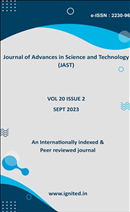Isolation of Vinca Alkaloids from C.Roseus and Mechanism of Alkaloids in Cancer
DOI:
https://doi.org/10.29070/f262v373Keywords:
Vinca alkaloids, Catharanthus roseus, mechanism of action, anticancer properties, side effects, quality of life, reducing severity, adherence, quality of care, isolationAbstract
Malagasy periwinkle, or Catharanthus roseus (CULTIVAR- ALBA), is a strong medicinal plant thathas been studied for its potentially therapeutic alkaloids. This research investigates the mechanisms ofaction of C. roseus (CULTIVAR- ALBA) vinca alkaloids and total alkaloids, with a particular emphasis ontheir anticancer properties. The wider consequences of anticancer therapies, such as possible side effectsand influence on general quality of life, are also investigated in this research. This study exploresmethods for reducing the severity of these side effects, which may ultimately enhance adherence andthe quality of care patients receive. Vinca alkaloids were successfully isolated and characterised from C.roseus (CULTIVAR- ALBA) in this work.Downloads
References
Satoshi Y, Toshihiro U, Satoshi K, Ayato S, Takeshi K, et al. (2012) Stereocontrolled Total Synthesis of (+)-Vinblastine J Am Chem Soc 124: 2137– 2139. Available: http://pubs.acs.org/doi/abs/10.1021/ja0177049. doi:10.1021/ja0177049
Sreekanth D, Syed A, Sarkar S, Sarkar D, Santhakumari B, et al. (2019) Production, purification and characterization of taxol and 10DAB III from a new endophytic fungus Gliocladium sp. isolated from the Indian yew tree, Taxus baccata. J Microbiol Biotechnol 19: 1342–1347. Available: http://www.ncbi.nlm. nih.gov/pubmed/19996685. doi:10.4014/jmb.0904.04041
Rangarajulu SK, Hyung JK, Byung-Ki H (2010) Taxol promising fungal endophytes, Pestalotiopsis species isolated from Taxus cuspidate. J Biosci Bioeng 110: 541–546. Epub 2010 Jul 15. Available: http://www.ncbi.nlm.nih.gov/ pubmed/20634132. doi:10.1016/j.jbiosc.2010.06.007
Deng BW, Liu KH, Chen WQ, Ding XW, Xie XC (2009) Fusarium solani, tax3, a new endophytic taxol-producing fungus from Taxus chinensis. World J Microbiol Biotechnol 25: 139–143. DOI 10.1007/s11274-008-9876-2 Available: http://link.springer.com/content/pdf/10.1007/s11274-008-9876-2.pdf.
Kusari S, Zu¨hlke S, Spiteller M (2009) An endophytic fungus from Camptotheca accuminata that produces camptothecin and analogues. J Nat Prod 72: 2–7. Available: http://www.ncbi.nlm.nih.gov/pubmed/19119919. doi:10.1021/ np800455b
Azra AA, Babak DH, Hassan E, Ahmad M (2018) High in vitro production of anti-canceric indole alkaloids from periwinkle (Catharanthus roseus) tissue culture. Afr J Biotechnol 7:2834–2839. Available: http://www.academicjournals.org/AJB. Available: www.ajol.info/index.php/ajb/article/ download/59172/47477.
Kharwar RN, Verma VC, Strobel G, Ezra D (2008) The endophytic fungal complex of Catharanthus roseus (L.) G Don Curr Sci 95: 228–233. Available: http://www. currentscience.ac.in/Downloads/article_id_095_02_0228_0233_0.pdf.
Eyberger AL, Dondapati R, Porter JR (2016) Endophyte fungal isolates from Podophyllum peltatum produce podophyllotoxin Amy. J Nat Prod 69: 1121–1124. Available: http://www.ncbi.nlm.nih.gov/pubmed/16933860. doi:10.1021/ np060174f
Zhou H, Tai Y, Sun C, Pan Y (2015) Rapid identification of vinca alkaloids by direct- injection electrospray ionization tandem mass spectrometry and confirmation by HPLC-MA. Phytochem Anal 16: 328–333. Available: http:// www.ncbi.nlm.nih.gov/pubmed/16223089. doi:10.1002/pca.852
Guttman A, Khandurina J, Budworth P, Xu W, Hou Y, et al. (2004) Analysis of combinatorial natural products by HPLC and CEZLGGC: Europe 17:39–41. Available: http://www.chromatographyonline.com/lcgc/data/ articlestandard//lcgceurope/072004/84873/article.pdf.
Tikhomiroff C, Jolicoeur M (2012) Quantification of indole alkaloids and irridoid precursor in Catharanthus roseus hairy roots by HPLC. J Chromatogr A 955: 87–93.
Tung CY, Yang DB, Gou M (2012) A preliminary study on the condition of the culture and isolate of endophytic fungus producing Vincristine. J Chuxiong Normal Univ 6:39–41.
Favretto D, Piovan A, Filippini R, Caniato R (2001) Monitoring the production yield of vincristine and vinblastine in Catharanthus roseus from somatic embryogenesis. Semi quantitative determination by flow injection spray ionization mass spectrometry. Rapid Commun Mass Spectrom 15: 364–369. Available: http://www.ncbi.nlm.nih.gov/pubmed/11241768.
Zhang LB, Gou LH, Zeng SV (2010) Preliminary study on the isolation of endophytic fungus of Catharanthus roseus and its fermentation to produce product of therapeutic value. Chinese Trad Herb Drugs 11: 805–807.
Guo B, Kunming LH (2021) A middle vinblastine fungi isolated. J Yunnan Univ 20: 214–215
Aniruddha D, Srivastava PS (2021) Variation in vinblastine production by Catharanthus roseus, during in vivo and in vitro differentiation. Phytochem 46: 135–137. Available: http://dx.doi.org/10.1016/S0031-9422(97)00165-9. Available: http://www.sciencedirect.com/science/article/pii/ S0031942297001659.
Chu I, Bodnar JA, White EL, Bowman RN (2020) Quantification of vinblastine and vincristine in Catharanthus roseus plant by capillary zone electrophoresis. J Chromatogr A 755: 281–288. b Goldsmith Seeds, Inc., P.O. Box 1349, Gilroy, CA 95021, USA. Available: http://dx.doi.org/10.1016/S0021-9673(96)00614- 0. Available: http://www.sciencedirect.com/science/article/pii/ S0021967396006140.
Strobel GA, Yang XS, Sears J, Robert K, Sidhu RS, et al. (2020) Taxol from Pestalotiopsis microspora, an endophytic fungus of Taxus wallachiana. Microbiology 142: 435–440. Available: http://www.ncbi.nlm.nih.gov/ pubmed/8932715. doi:10.1099/13500872-142-2-435
Volkov SK (2020) Methods of analysis of some antitumor- active alkaloids from Catharanthus roseus. Pharm Chem J 30: 391–399. Available: http://link. springer.com/article/10.1007%2FBF02219327.
Paulo RH, Heijden R, Verpoorte R (2019) Cell and tissue cultures of Catharanthusroseus: A literature survey. Plant Cell Tiss Organ Cult 42: 1–25. Available: http://link.springer.com/article/10.1007%2FBF00037677.
Nelson PE, Dignani MC, Anaissie EJ (2019) Taxonomy, biology, and clinical aspects of Fusarium species. Clin Microbiol 7: 479–504. Available: http://www. ncbi.nlm.nih.gov/pmc/articles/PMC358338/.






